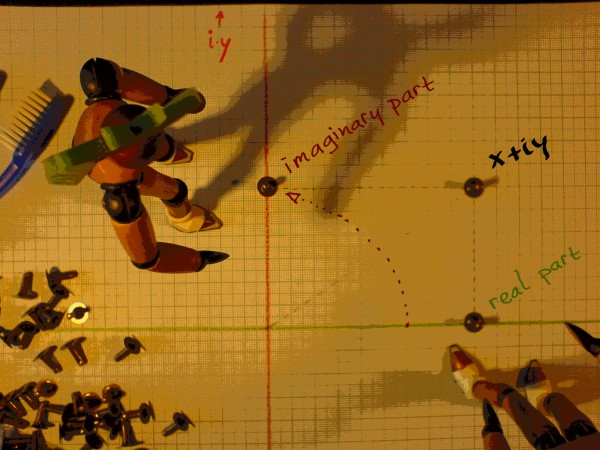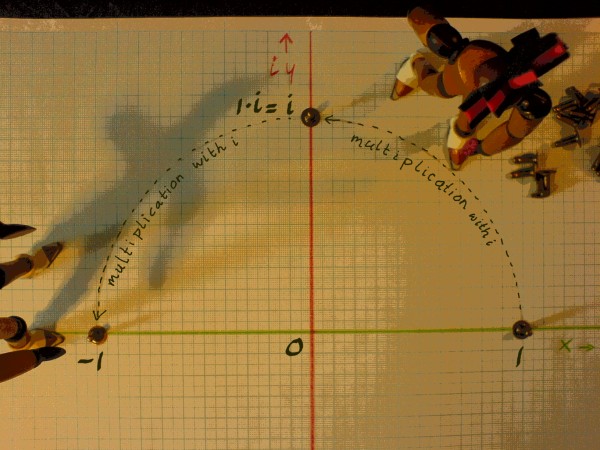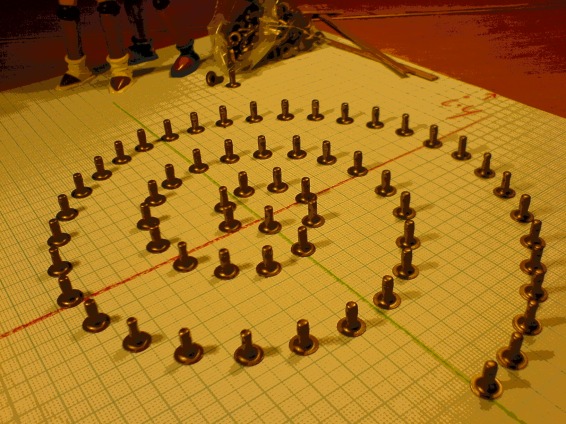
Intro
Complex numbers are our best friends, I mean of us dsp-freaks. These numbers can act as a 'lever' to manipulate phase, frequency or amplitude of signals. And they shine their light on the nature of periodic motion. Because, despite their title, they simplify matters. That is, once you get the concept. So what are these complex numbers?
Start from a plain real number somewhere on the x-axis. That may
be an audio sample value or any piece of data. There is a vertical axis on
the complex plane, yes, but it is not the familiar one where y is
plotted as
a function of x. Here is no space to draw a sinewave as a function of
time, for example. Instead, we use the whole surface to supply extra
information on data-points. Such a data-point has two coordinates. It
is a two-dimensional vector indeed, albeit of a special kind.
 |
The vertical coordinate is said to
be: a real number multiplied by i. Multiplied by i.....hmm? A letter!
Basically, a number can be considered multiplied-by-i when it is on the
iy axis of a complex plane. Take a number from the x-axis, rotate it
anti-clockwise to the y-axis, and there you have it.
 |
That unconspicious letter i makes the difference between two
dimensions. The value on the x-axis is called a real number. The number
multiplied by i and thus residing on the iy axis is called imaginary
number.
Accordingly, the vector contains a real part and imaginary part.
A complex vector is notated as:
|
(x+iy) |
For example:
(0.63+i0.45). You can have
negative i just as well: (0.63-i0.45). And the real part could be
negative too: (-0.63-i0.45). In contrast to ordinary vectors of the
form (x,y), complex vectors have no comma to separate the values. A
comma is not needed, because the letter i already identifies the second
value.
 |
Because of a peculiarity of i, complex
vectors can be added and subtracted like ordinary vectors, but also
multiplied, divided, or even be subject to powers or roots. That
peculiarity of i is defined this way:
|
When i is squared, it makes -1. |
That is an agreement. The definition i*i=-1 looks strange at first
sight. From wikipedia-articles I understand that it took a couple of
centuries after the invention of imaginary numbers, before the academic
community got really comfortable with them. So, do not feel discouraged
if you don't get it in a few seconds.
Fortunately, the definition has a geometrical representation, which
means it can be visualized. Multiplication by i is an anti-clockwise
rotation of a quarter-circle. Multiplying 1 by i gives i. Multiplying
i, by i once more, does another quarter-circle and gives -1. So,
multiplying by -1 means a rotation of a half-circle. That is the
meaning of i*i=-1.
 |
Let us look at an important consequence of the
definition. Every complex vector has an
i in it, therefore complex multiplications will always show an certain
amount of i*i
effect. Two vectors (a+ib) and (c+id) are multiplied like this:
|
(a+ib)(c+id) |
The part without the i-label is the real product: ac-bd. The part
with the i-label is the imaginary product: i(ad+bc). So computing the
complex product (a+ib)(c+id) boils down to computing (ac-bd)+(ad+bc)
and labeling the latter part with i:
|
(a+ib)(c+id) = (ac-bd)+i(ad+bc) |
At this point you may not feel so exited about the whole operation yet. But take a look at the image below. Such a series could result from repeated complex multiplication:
 |
This spiral figure on the complex plane translates to decaying
(co)sinewaves when real parts or imaginary parts are plotted as
functions of
time. To make a digital resonator, is as simple as this.
 |
Still it is hard to grasp how complex multiplication can produce this
effect, going round in a (quasi-)circular motion instead of straight
ahead. Regarding this question,
a matrix perspective on complex multiplication can help.
goto>> ../the
matrix representation